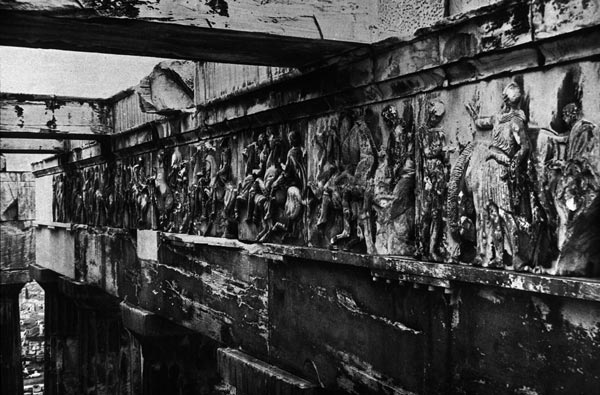The Parthenon Frieze
CR: When I first saw your paintings of the Parthenon frieze, I liked them immediately. I found them really captivating. I think what I liked about them first was what I liked about the Parthenon frieze itself (or rather, what I liked about the photographs of the frieze that I came to know and love, long before I ever saw the sculptures themselves), namely, the subject: a procession of men and women of all ages come together on some great occasion of which the central feature is a parade of young horsemen who project an extraordinary sense of inner discipline, in part because they seem to manage their unruly horses so effortlessly. There is a beautiful informality to it, so that it is serious without being solemn, grand without being grandiose. Earlier on, you commented on the “compelling blankness” of some ancient faces, and that is a great way of describing the expressions of the figures on the Parthenon frieze. It is that blankness that makes them seem so calm and self-controlled.
Here’s a comparison: on important occasions in western Turkey, men perform a traditional folk dance called the Zeybek, famous for its elaborate footwork and its stately pirouettes. But the parts of the Zeybek I find most elegant are the moments in between the formal steps, when the dancers simply walk around in a circle, bodies loose, heads down in concentration, moving casually but purposefully to the music… the Parthenon frieze projects something of the same mood and rhythm, and I think you have captured that in your paintings.
Now as I learned more about Greek sculpture and finally traveled to London to the see the frieze for myself in the British Museum, I began to appreciate other aspects of the monument, the intricate composition of its densely packed and overlapping figures, the extraordinary craftsmanship, the materiality of the stone. In the same way, as I have studied your paintings, I realize that part of what appeals to me in them is the texture of the paper, the tonality of the pigment, and the fascination of the way you use the play of light and shadow to give volume to the figures that you paint.
So those are some of my reactions to your paintings: what drew you to this subject? What are you trying to achieve by painting the Parthenon frieze?
WA: When I first saw the Parthenon frieze at the British Museum, I was dazzled by the rhythmic movement of the immortal horses and riders, by the long, delicate, powerful parade of stone.
The frieze bears eloquent witness both to the finesse of its designers and carvers and to the ravages of time; its figures literally embody the dialogue between time and civilization. Drawing something is a way of being with it for a long time, staring at it for a long time. For years, I dreamed of painting the frieze, of spending hours getting lost in the cracks and relief, understanding the movement of the heads, the bodies, the legs. I was not able to move my family to London but instead decided to make pictures at a scale that I could not possibly have done in situ, using photos. The frieze has a solid band of horse and rider bodies running through the middle of the frame. The heads are visible at intervals above the bodymass, the horses with almost wild expressions in contrast to the grave, impassive gazes of the horsemen. The legs form rhythmic patterns below, musical, counterpointed in the delicate manes and the fluted folds of the drapery. There is a surprising combination of movement and utter stillness.
Painting them I discovered that the cracks and fragmented rock were almost as visually compelling and certainly as demanding to represent as the sculpture itself. In one of the paintings, only one face remains, the rest being just craggy rock, suggesting the ghost of what was once there. As I painted, I found myself wondering about how much I was paying tribute to the bravura of the ancient and extraordinarily skilled sculptors and how much to the hand of time.
I wanted the image to emerge from the paper with no discernible start or finish, as happens in the process of drawing. I tried to capture all of the gradations of tone within one wet wash, before the brushstroke dried, pushing a dark in here and lifting light out there, in order to keep the watercolor fresh, light, on the surface. The organic surface and irregular absorption of the handmade rag paper that I use lends itself to the depiction of the stains of age, the crumbling of rock. I wanted the illusion to be almost total, for the realism to pull the viewer in at the same time that the brushstrokes remind one that this is simply wet pigment that has stained the fibers of the paper. By the end of the project, walking into my studio with the seven life-sized Parthenon frieze paintings felt a little like walking into the Duveen Gallery of the British Museum.

